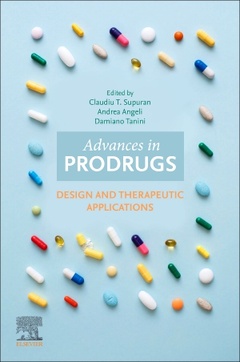Description
Advances in Prodrugs
Design and Therapeutic Applications
Coordinators: Trandafir Supuran Claudiu, Angeli Andrea, Tanini Damiano
Language: English
Subject for Advances in Prodrugs:
Publication date: 09-2024
350 p. · 15x22.8 cm · Paperback
350 p. · 15x22.8 cm · Paperback
Description
/li>Contents
/li>Biography
/li>Comment
/li>
Advances in Prodrugs: Design and Therapeutic Applications provides a versatile tool in prodrug design and development as well as a concrete perspective on clinical and preclinical studies currently available on prodrugs. The first part of this book discusses different chemical classes of prodrugs, with particular emphasis on metabolic pathways and mechanisms involved in the activation of their functional groups. The second part of the book covers therapeutic applications of prodrugs against the most discussed diseases, providing detailed discussion on recent achievements in the field. This book offers researchers involved in drug discovery key criteria for the successful development of prodrug-based therapeutic tools.
Prodrugs are inactive drug precursors which undergo different chemical transformation by metabolic processes to provide pharmacologically active compounds. Prodrugs include a broad range of structurally diverse molecules employed for the treatment of several diseases.
Prodrugs are inactive drug precursors which undergo different chemical transformation by metabolic processes to provide pharmacologically active compounds. Prodrugs include a broad range of structurally diverse molecules employed for the treatment of several diseases.
Part 1 Introduction
1. Prodrugs: general concepts, prodrug design in medicinal chemistry
Part 2 activation mechanisms and related functional groups
2. Ph-sensitive prodrugs
3. Enzyme-mediated activation of prodrugs
4. Reactive oxygen species-responsive prodrugs
5. Photoactivable prodrugs
6. Antibody directed enzyme prodrug therapy (adept)
7. Self-assembling prodrugs
8. Carrier-linked prodrugs
9. Hypoxia-activated prodrugs
Part 3 application of prodrugs in the treatment of diseases
10. Antiviral and antiretroviral prodrugs
11. Prodrugs for cancer therapy
12. Prodrugs for neurodegenerative diseases
13. Prodrugs in cardiovascular therapy
14. Prodrugs for inflammatory diseases
15. Prodrugs for ocular diseases
16. Antibacterial prodrugs
17. Prodrugs against neglected diseases
1. Prodrugs: general concepts, prodrug design in medicinal chemistry
Part 2 activation mechanisms and related functional groups
2. Ph-sensitive prodrugs
3. Enzyme-mediated activation of prodrugs
4. Reactive oxygen species-responsive prodrugs
5. Photoactivable prodrugs
6. Antibody directed enzyme prodrug therapy (adept)
7. Self-assembling prodrugs
8. Carrier-linked prodrugs
9. Hypoxia-activated prodrugs
Part 3 application of prodrugs in the treatment of diseases
10. Antiviral and antiretroviral prodrugs
11. Prodrugs for cancer therapy
12. Prodrugs for neurodegenerative diseases
13. Prodrugs in cardiovascular therapy
14. Prodrugs for inflammatory diseases
15. Prodrugs for ocular diseases
16. Antibacterial prodrugs
17. Prodrugs against neglected diseases
Claudiu T. Supuran received his BSc and PhD in Chemistry from the Polytechnic Univesity of Bucharest (Romania), where he became an Assistant and then Associate Professor of Chemistry. In 1995, he moved to University of Florence, where he is Full Professor. His main research interest focused in medicinal chemistry, design of enzyme modulators especially in the carbonic anhydrase field, X-ray crystallography and molecular biology of metalloenzymes. He has published more than 1900 papers in these fields and his Hirsch index is 155, with > 105 700 citations. One of the compounds discovered in his laboratory (SLC-0111) is in Phase II clinical trials for the treatment of advanced metastatic solid tumors in Canada/USA, whereas a monoclonal antibody of which he is co-discoverer (6A10) is in preclinical evaluation and anti-tumor theragnotic agent. He is the editor-in-Chief of Journal of Enzyme Inhibition and Medicinal Chemistry and of Expert Opinion on Therapeutic Patents.
Andrea Angeli obtained his MSc in Medicinal Chemistry and Technologies in 2014 and his PhD in Medicinal Chemistry in 2019 at the University of Florence (Italy). After he spent three years as Assistant researcher at the Centre of Advanced Research in Bionano conjugates and Biopolymers Department, “Petru Poni Institute of Macromolecular Chemistry (Romania). From 2020 is visiting researcher to University of Florence. His research deals with several aspects of metalloenzymes, spanning from drug design, X-ray crystallography and synthesis of enzyme modulators.
Damiano Tanini received his PhD degree in Chemistry in 2015 from the University of Florence working on the stereoselective synthesis of sulfur- and selenium-containing compounds. He carried out part of his doctoral research at the University of Bristol, working with Prof. V. K. Aggarwal. D. Tanini is currently a researcher in Organic Chemistry at the University of Florence. His research interests currently centre on organic synthesis, ranging from
Andrea Angeli obtained his MSc in Medicinal Chemistry and Technologies in 2014 and his PhD in Medicinal Chemistry in 2019 at the University of Florence (Italy). After he spent three years as Assistant researcher at the Centre of Advanced Research in Bionano conjugates and Biopolymers Department, “Petru Poni Institute of Macromolecular Chemistry (Romania). From 2020 is visiting researcher to University of Florence. His research deals with several aspects of metalloenzymes, spanning from drug design, X-ray crystallography and synthesis of enzyme modulators.
Damiano Tanini received his PhD degree in Chemistry in 2015 from the University of Florence working on the stereoselective synthesis of sulfur- and selenium-containing compounds. He carried out part of his doctoral research at the University of Bristol, working with Prof. V. K. Aggarwal. D. Tanini is currently a researcher in Organic Chemistry at the University of Florence. His research interests currently centre on organic synthesis, ranging from
- Highlights chemistry and pharmacology-related aspects, offering a versatile tool for readers involved in prodrug development and study
- Discusses in-depth treatment of several activation mechanisms and applications for disease treatments
- Covers a range of topics from basic contents, design, and mechanisms of actions to current applications in drugs
© 2024 LAVOISIER S.A.S.




